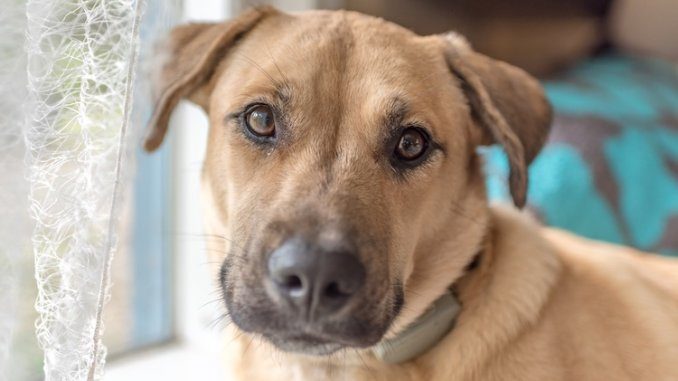
Historically a working dog, the Black Mouth Cur isn’t for first time dog owners.
High in energy and tenacity, he is super intelligent and trainable.
When loved by the right owners, he is the perfect family dog, but only for those who understand what he needs and know how to give it to him.
A medium sized dog breed, who sometimes has webbed feet, he is perfect for an active family who love spending time outside.
The Black Mouth Cur has everything a working dog should.
Interested in getting this loyal dog? Read on to find out more.
TABLE OF CONTENTS
Black Mouth Cur Dog
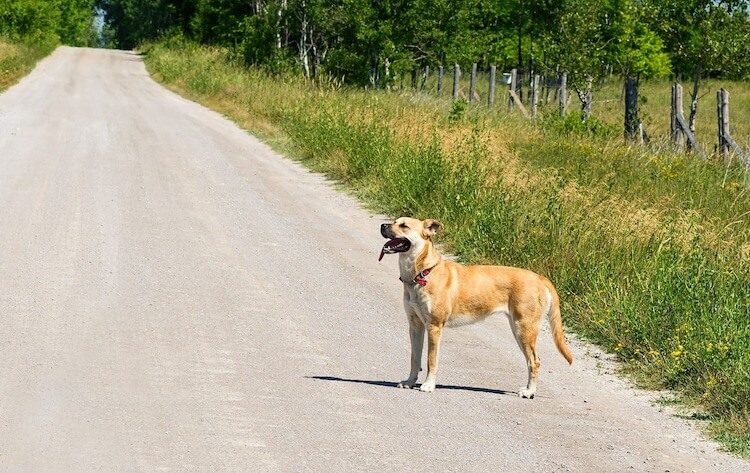
From Adobe Stock
The Black Mouth Cur is a powerful and muscular dog with a body which is usually square or at least longer than tall.
They are tenacious dogs with an innate desire to work.
Known for being hunters, this dog is built to move efficiently over harsh terrain for long periods of time.
It is thought that the original Curs were found across Europe and Asia. But, the Black Mouth Cur has its history in Southern United States hence its nickname as the “Southern Cur Dog”.
It’s unclear which state this dog first appeared in, there is some confusion whether it was Tennessee or Mississippi.
What seems more likely is there is a slight differentiation within the breed depending on region they originate from. We know there are Black Mouth Curs from three different parts of the states:
- Foundation Black Mouth Curs (Texas)
- Ladner Yellow Black Mouth Cur (Mississippi)
- Black Mouth Cur (Florida)
Cur is a general term meaning a dog with a short coat and drop ears, with working heritage.
Farmers bred and kept the Black Mouth Cur dog to protect their home, hunt and herd cattle and sheep ready for slaughter (they are an incredibly versatile dog).
Kennel Club Recognition and Pedigree
The Black Mouth Cur (BMC) was recognized as an official dog breed in 1998 by the United Kennel Club.
Their successful breed registration resulted in a breed standard which can help to identify BMCs and maintain the quality and consistency of the breed with appearance and temperament.
| Size | 16-25 inches in height (for males and females) |
| Weight | 35-40 lb (for males and females) |
| Lifespan | 12-18 years |
| Breed Type | Scent Hound |
| Purpose | Working Dog |
| Suitable For | Active Families |
| Color Variations | Red, Yellow And Fawn, Brindle, Buckskin With Or Without A Black Muzzle Or Mask |
| Temperament | Intelligent, Fearless, Courageous, Energetic And Loyal |
| Known Health issues | Southern Cur, Yellow Black Mouth |
Black Mouth Cur Puppies

From Adobe Stock
Litters of this dog are often quite large, ranging from between 3 to 12 Black Mouth Cur puppies.
For one of these super-smart working dogs you should expect to pay between $300-500 USD.
If you are looking for a puppy, you may notice these dogs are commonly labelled as hunting or herding bloodlines.
Whilst Black Mouth Curs are generally able to do both (herding and hunting), you will find that certain lines will have been bred over generations, and consequently refined, to do a particular task.
Males and females can also differ greatly with their ability to perform a certain role:
- Males are generally better at hunting, they are larger so therefore more intimidating. They are also more easy-going.
- Females are thought to be better house dogs as they mature sooner and are an overall smaller size.
Being a medium sized dog, they are likely to mature around 12-18 months of age.
Fully grown, a male should be no shorter than 18″ at the shoulders and a female should be no shorter than 16″.
Black Mouth Cur Temperament
Being a working dog, it should be no surprise that the Black Mouth Cur is high in energy.
He would have needed stamina and endurance to wander on harsh terrain, hunting and herding with his farmer. Bringing him to the modern-day home, you can be sure he needs plenty of exercise and he loves being busy!
Not only that, but he was bred to protect his home.
He loves his people! They don’t tolerate being left alone, so he’s best suited to homes where someone can be with him most of the day.
Destruction and despair lay in wait if you make the mistake of leaving him home alone for extended periods of time.
If he gets bored, he will give Huskies a run for their money.
Black Mouth Curs are renowned for being escape artists if their daily exercise needs aren’t met. Over, under or through fences, they will find a way.
They will dig if they are bored, but they will also dig a hole to sit in and cool down.
Not renowned barkers, they will only alert you to something out of place. But some hunting lines of Black Mouth Cur do bark more than others.
They also have a particular talent for opening doors!
Do They Make A Good Family Dog?
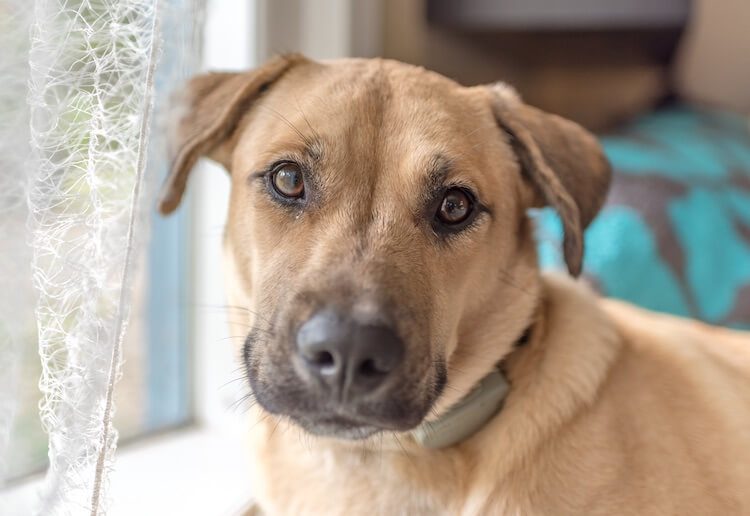
From Adobe Stock
When raised with them, this dog can be super-sociable with people and other animals.
Again, it’s worth discussing with a responsible breeder what you are looking for.
If he’s just going to be a pet, tell them that. Their working lines of Black Mouth Cur may not be suitable for you.
They can be the perfect family pet, but they need an experienced handler who understands their heritage.
Care Guide
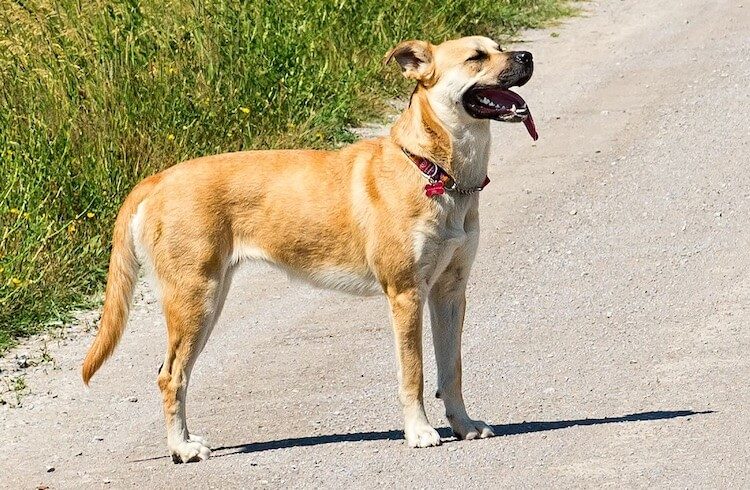
From Adobe Stock
Not for first time dog owners, the Black Mouth Cur keeps even the best dog handlers on their toes.
They thrive in an active home, where his owners have the time to exercise and train.
Let us see if you’ve got what it takes to care for him on a daily basis.
Food and Dietary Requirements
| Daily Food Consumption | |
|---|---|
| Guide | 1,000 calories |
| Cups of Kibble | From Adobe Stock |
When feeding your Black Mouth Cur, ensure you invest in a high-quality food.
Check it meets his nutritional requirements, especially protein and fat:
- Protein is the building blocks of your dog’s body – cells need it to function, develop and repair.
- Fat is crucial for energy and we know this dog will use a lot of that!
Between 4-14 weeks of age, your Black Mouth Cur puppy will need a minimum of 4.4g of protein per kg of bodyweight.
At 14 weeks onwards he will need 5.69g, and once fully matured, this will reduce to 1.20g of protein per pound of bodyweight.
Your puppy will need 8% of his diet in fat form, this will reduce to 5% when he is fully grown.
As a puppy split his meals into three per day. once fully grown, most owners reduce this to two.
Be mindful not to overfeed, though not prone to weight gain, high calorie treats should be used sparingly.
Exercise Requirements
| Daily Exercise Requirements | |
|---|---|
| Minutes | 120 minutes |
| Activity Level | From Adobe Stock |
As we mentioned, the Black Mouth Cur was a historic herding dog.
They love being active and need a high level of exercise.
Two 60-minute walks per day, when fully matured, should get you on the right track to meeting his needs.
They also thrive in sports like agility and flyball, being super trainable means they can turn their paw to anything!
Their webbed feet make them excellent swimmers too, so this is also an option if the weather is a little too warm to be out trekking all the time.
If you do decide to take them swimming, remember to stay safe and consider investing in a life jacket for your dog!
While being highly trainable, be mindful that they were bred to be hunters. Although you may have trained recall to within an inch of their life, if they spot something more interesting than you, they will follow their nose (or ears or eyes).
Keep them on leash in busy or non-secured areas.
Training Requirements
Not only do you need to keep their bodies active, but you need to keep their minds active too.
Black Mouth Curs are highly intelligent and super-trainable.
It can take a few weeks for them to bond with their owners as puppies so ensure you focus on play to build that relationship initially.
They thrive with positive reinforcement and reward-based training. Despite their heritage, they can actually be quite sensitive so it’s even more crucial to avoid aversive training techniques.
Understand if your puppy is a food or toy dog and use it to your advantage.
Spend time working through brain games to keep him out of mischief.
Playing to his hunting heritage, you could set up a treasure hunt in your home and around the yard. Hide toys or high value treats and encourage him to seek them out.
Known Health Problems
Because they were bred for hunting, the Black Mouth Cur is typically a very healthy dog.
The normal lifespan for a Black Mouth Cur is between 12 to 16 years.
Typically healthy, however, they can still suffer with certain health issues relating to their ears.
Because of their dropped ears, they can be prone to ear infections, especially if they spend time swimming.
Check his ears regularly and clean them when necessary. The flat lay of their ears keeps the humidity in the ear canal which is a perfect environment for bacteria to survive.
Black Mouth Cur Size, Appearance, Coat and Grooming
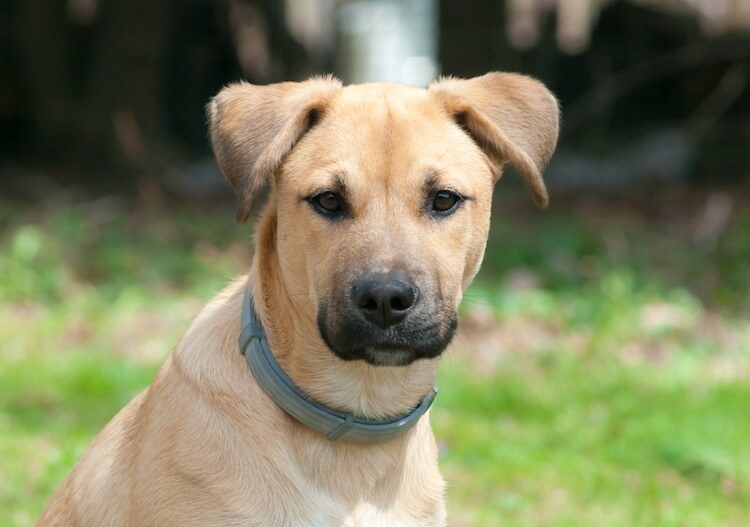
From Adobe Stock
The Black Mouth Cur is a medium sized dog, powerful and agile.
Their body is usually square or at least longer than it is tall and they can move quickly and efficiently.
They have a large, broad head and their ears are dropped of medium length (set quite high on the head).
Despite the name, the breed standard accepts Black Mouth Curs with, or without, a black muzzle or mask.
They have a short, dense coat, which can be coarse, rough or fine.
You will find Black Mouth Curs in a range of colors including:
- Red
- Yellow
- Fawn
- Black
- Bronw
- Buckskin
- Brindle
Relatively low with their grooming requirements, two or three brushes per week should be ample to keep on top of his coat.
Being a short coat, you won’t notice too much hair around your home.
Introduce brushing from a young age and make it part of your routine. Not only does it make your life easier moving forward, but it means that a Veterinarian can check him over whenever the need should arise.
Get into the habit of brushing his teeth multiple times a week, and whilst you’re at it, check his eyes and ears.
If he has webbed feet, keep an eye on them too! Just ensure nothing has gotten stuck in between his pads.
Summary
A historic worker with oodles of energy, this dog is not for the first-time owner.
If you are seeking a Black Mouth Cur puppy, research your breeder and speak with them about the differing bloodlines.
Also consider whether a male or female may be more suitable for your home.
When raised with them, Black Mouth Curs are super-sociable with other people, children and animals, but again it is down to the experience of the handler and their understanding of early and continued training and socialization.
These dogs are sensitive, so reward-based training is a must.
Their sensitive side will also show if they are left for long periods of time, they are much happier in homes where someone will be with them for most of the day.
Known escape artists, and diggers if their needs are not met, make a mistake with a Black Mouth Cur at your peril.
They make incredible family dogs, who just love their family. They are intelligent and courageous, you just need to be one step ahead of them!




Hi! I rescued a puppy when she was 1 week old, now she is about to be one year old. Looking on your article, it looks like she may be a black mouth cur. I was wondering if it is possible to send you some pictures and have your opinion? Thanks as I rescued her from the streets I don’t have any information about her parents.
Hi Natalia,
Please feel free to send pictures via our contact page.
We just adopted a sweet Black Mouth Cur. This is a great article and explains EVERYTHING that we are seeing in him. He’s about 4-5 months old and has non stop energy! We are avid hunters and already own an older Louisiana Catahoula Leopard/Vizsla mix. They get along swimmingly, and have much to teach one another. Our Catahoula already trees, and is teaching our pup (his name is Taco), how to tree. He is such a snuggle bug, and is very protective while he’s in the house, yet is extremely social outside of the home. I appreciate the details in your article, and explaining some of the aspects we’ve been noticing. We cannot keep him busy enough though! We have multiple walks daily, have a huge jungle of a yard with many places to explore, bones everywhere, and yet he’s still managing to chew/eat EVERYTHING he can put his mouth on. He’s worse than a toddler! He’s picking up basic training extremely quickly, and we look forward to training him on our wild game ranch. Thank you for the detailed information!
We adopted a rescue black mouth cur puppy almost 3 years ago. He was brought over from Puerto Rico. Unfortunately, I don’t know what he endured up until the time we adopted him, but he came with alot of “people” fear and distrust. Even after 3 years of owning him, he still has fear and distrust issues. He has made progress, and I attribute alot of that to our other dogs – he follows their lead. But I wonder what else we can do to help his emotional issues heal?
Have you had any professional support with his issues? It is key to maintain a positive environment for him and take things at his pace. You say he has made progress, which is brilliant! Well done for persevering. It could just be that it will take time. Let him spend time with predictable humans; routines are a great help for fearful dogs. Try not to overwhelm him with lots of new people. Have you set up a den in the home? It could be a crate with a cover over, a space under the stairs or just a quiet room where no one really goes. You can show him that it’s his space and he can retreat there whenever the world is getting too much. This is really handy for when you have guests over; I imagine this is a source of worry for you quite often. With other dogs in the home, they’ll probably go into that space too, which, if he finds them as a source of confidence, it’s fine to allow. I’m sure he’ll continue to make progress with you; you seem to really care about his welfare.
Dee, About 3 years ago, I also rescued from Puerto Rico an apparent Black Mouth Cur through the Sato Group. We started out observing the same behavior as you did. Over the past 3 years or so, her behavior has dramatically changed for the better and now she is the near perfect family pet. She is a super motivated “food reward” dog who will do anything for a piece of chow.
I should have added to my prior response that this article describes my rescue BMC’s behavior perfectly. Thank you!
All of these comments regarding fear and distrust issues make me think these issues must be a common trait in these dogs. We have two males. One is extremely friendly and the other [was] extremely nervous and skittish. Persistence and repetition along with enthusiastic praising will win these personalities over eventually, but it takes a lot longer than average. Seems they have a mind of their own and stubbornly resist changing it. But they WILL get better and better as time goes on.
I adopted a black mouth cur mix about a month ago. She fits the descriptions on this page about being stubborn, smart, and an escape artist. However, she’s mellow otherwise. Two 30 minute walks and some yard time and she is usually fine. Prey drive is incredibly high though! She barks occasionally but usually at other dogs that are playing rough. Extremely loyal, and occasionally will growl at tall men/ people with helmets. What interesting is how she doesn’t tend to respond well to typical dog training methods. She is food motivated but if I try to train her with a lot of food she tends to do worse. I try to keep quite unless she need correcting and praise her occasionally. Not sure if this is just her or the breed though.
We are about to adopt an 8 month old rescue from the south. All of the above descriptions scare me! We have 5 year old “almost perfect” lab/hound rescue from Tennessee. First year was tough with her, and she ate my glasses, some linoleum, a starfish, but apparently she has a stomach of iron. We have a secure fenced in yard. Should I be afraid our new rescue will escape?.She eats sticks and bunny turd now, but I can take her to the beach off leash. She chases sea birds but always comes back. She loves being with other dogs. Will she help train our new girl?
We rescued a 9 year old black mouth cur from an abusive home. She is the best dog we ever had! Your article explained so much. We didn’t even know she had webbed feet. (Only had her for a week) thank you for the great article!
We rescued our Southern Cur at the age of 6 months and she just knew she wanted us as much as we wanted her. At the shelter my 4 yr old son tripped and began to cry. Liberty Belle (named so because she was adopted the day before Independence Day and showed us from day 1 that she was a princess) ran over to him, sat and cocked her head, she kept trying to nuzzle him until her eager puppy attitude got the best of her and she got up on him and licked every tear. 2 months in our home and those two are inseparable. When Liberty gets bored, she goes into my son’s room to cause mischief. My son is also a rough 4 year old. He gets excited and wants to hug her tight and grab her face. She’s patient with him but sometimes forgets that she’s bigger and heavier than him LOL. It really has been like having 2 preschoolers in the house but our Liberty is incredibly smart, travels really well and adores our 3 kids. She LOVES dog parks and sniffing every blade of grass on our walks since we live in an area where there are a lot of deer. Our backyard is littered with dog toys because we sort of spoil her with them but the love and companionship she’s developed in such a short time makes it hard to not want to shower her with cuddles and special toys. We were looking for a small breed to adopt because we felt we weren”t going to be able to give a larger dog the attention and exercise but that’s what makes Curs perfect for families. She plays with the kids in the yard and burns all the energy so at night she passes out all night. We couldn’t think of a better dog for our family!
We adopted an eight months old puppy called „Fox“ from Hungary/Europe and a thrilled to find out about his origins… the descriptions meet his charcter in many aspects. Greetings from Munich, Germany!